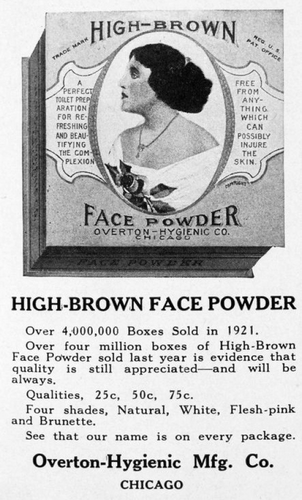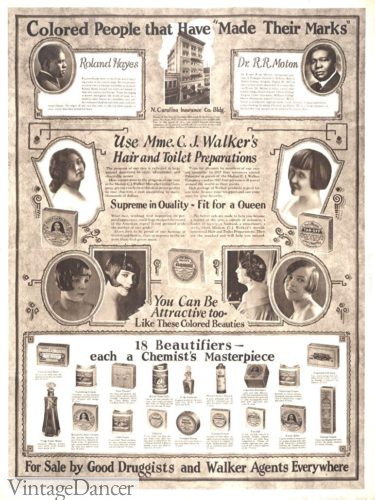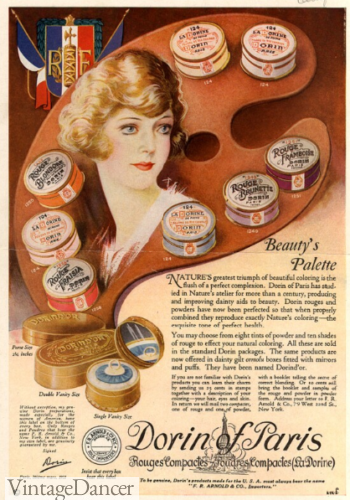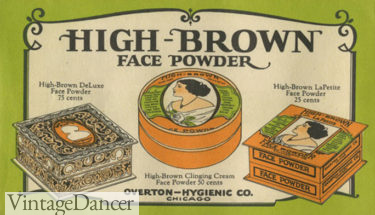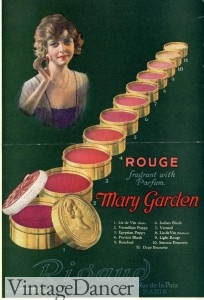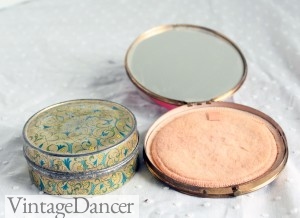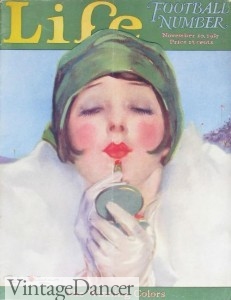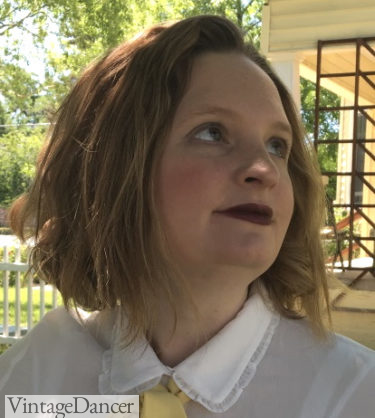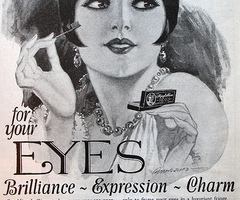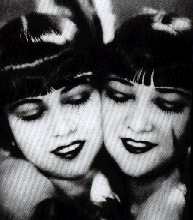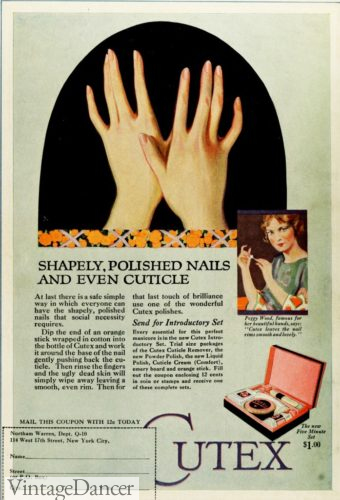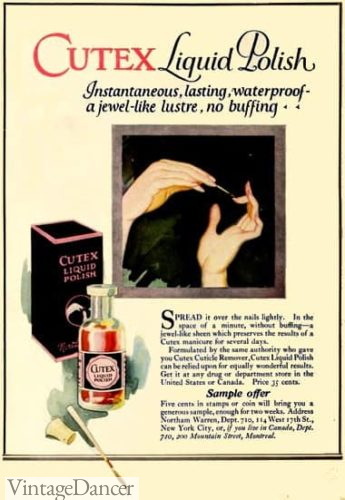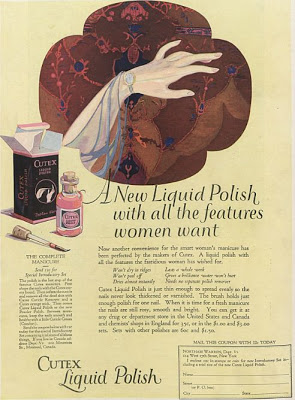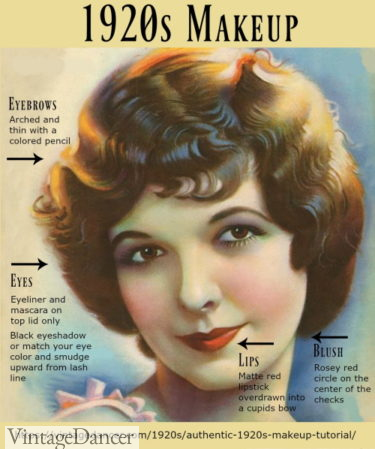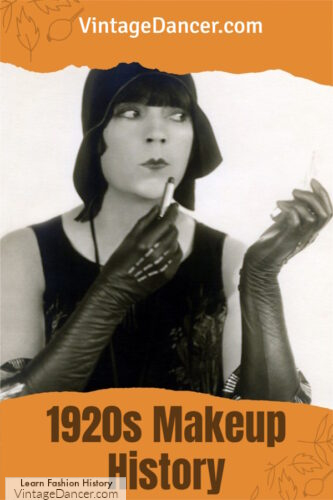
Before the 20th century, “nice girls” did not wear makeup, which was commonly called “paint.” This differed from cosmetics, such as face creams and similar products that were intended to improve the skin, not mask it in the way that paint did. Even into the 1910s, what we would call makeup today was associated with prostitutes, dancing girls, and movie stars.
It was the silver screen that made young women flock to the beauty section of their local department stores.
What kind of makeup was popular in the 1920s? Read on for the authentic history of 1920s makeup as worn by real everyday women.
At first, beauty products were not about changing one’s look but about enhancing natural beauty. Face creams, lotions and powders all helped even out skin tone. Getting a “facial” at a “beauty salon” was unheard of in 1917, but by 1929 the beautician industry had 18,000 beauty parlors in America. The industry of women’s beauty services had exploded.
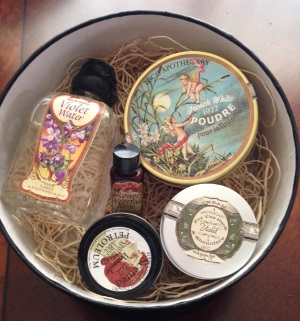
LBCC Historical now makes 1920s reproduction beauty products! They smell like vintage heaven!
1920s Makeup Brands
The number of beauty products and cosmetic lines exploded, too. Helen Rubinstein and Elizabeth Arden worked with chemists to make some of the first sun blocks. Since the sun tan and sun burn were in style, Arden turned her attention to creating powders that were tinted to help make a sun kissed glow. She also made liquid rouge, eye shadows, and lip sticks. Shade choices were minimal- light, flesh and tan.
A few other makeup brands of the 1920s were Djer-Kiss, Maybelline, Pompeian, Kiss Proof, Mary Garden, and Coty. Additional brands only offered face powders such as Mavis, Lady Janis, Edna Wallace, Mello-quo, and Colgate. These are American brands sold in common drugstores. The European and French market had different brands.
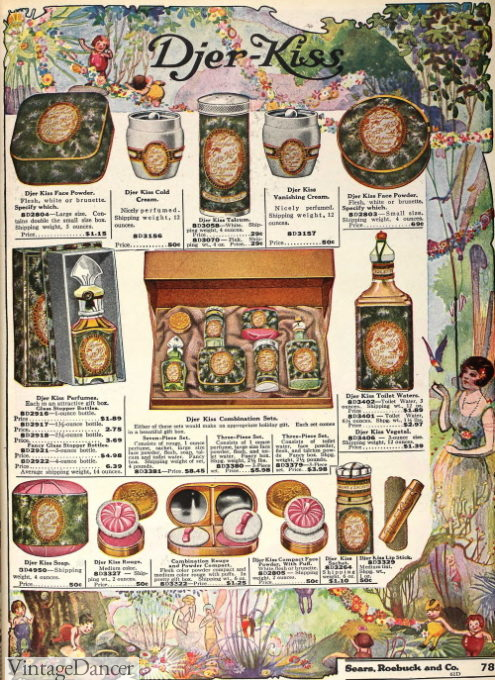
1920 Der Kiss beauty product line
Despite the wide range of makeup brands by the end the 1920s, very few designed colors specifically for black and Latino women and almost none of them were sold in local shops.
The Overton-Hygienic Co. made the high-brown line of face powders in 1916. Valmor Health Products Company started in 1926, made the Sweet Georgia Brown line of face powders and makeup. Madame CJ Walker, know for her care care, expanded to include face powders and rouge by the end of the decade.
- 1921 Overton High-brown face powder
- Mdm CJ Walker’s beauty line
These brands used direct sales (traveling sales persons, often women) and mail order catalogs to provide direct sales to women. Despite the effort and success as a business, their sales made up only a small percentage of black women’s makeup purchases. The average woman used drug-store brand lipstick, rouge and eye make up in suitable colors for her complexion.
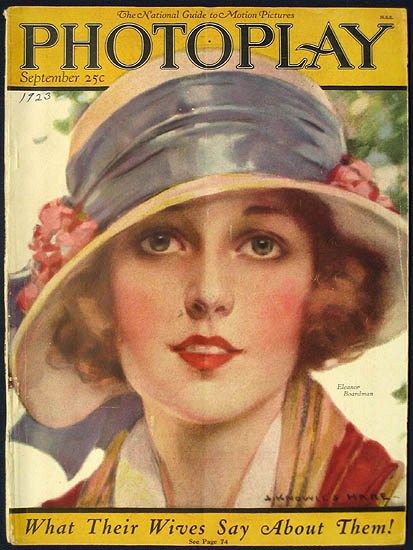
The innocent doe-eyes girl was the preferable makeup style of the early 1920s. Photoplay circa 1923
1920s Makeup Colors
Most makeup in the 1920s was limited to just a few shades that never matched natural skin tone. The initial look of women in makeup was ghastly! With limited colors, chalky foundations, and no previous generations of women to teach them how to apply makeup, the first attempts were anything but glamorous.
Women didn’t seem to mind. In their eyes, makeup was intended to draw attention to their face, to elicit reactions, to look like a movie star.
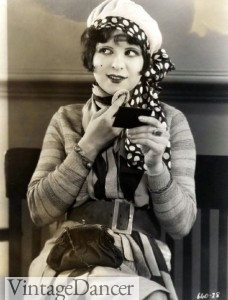
Clara Bow’s Makeup
Men, however, didn’t appreciate the “face masks.” They may have noticed it, but they certainly didn’t swoon over the unnatural qualities of makeup. They also didn’t like that women pulled out their makeup and mirrors and applied it right at the dinner table instead of going off to the powdering room. Men secretly missed the days of the demure Victorian porcelain dolls.
- 1922 Dorin of Paris face powders
- High-Brown face powders
As the decade progressed, the quality of makeup improved. The number of products went from a few dozen to 450 by 1924. By the end of the twenties, there were 1300 brands and shades of face powder, 350 rouges, and a hundred red lipsticks. It was a 52 million dollar industry.
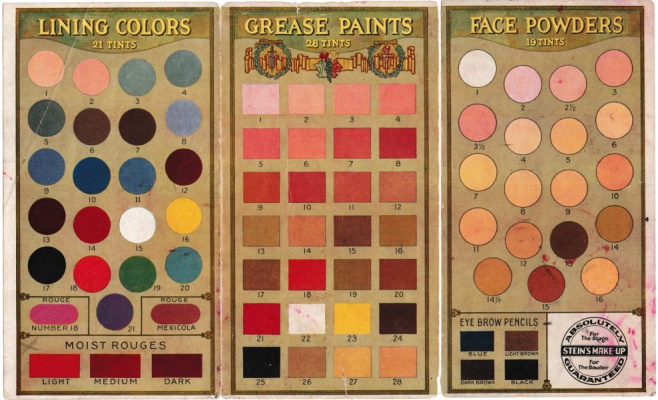
Stein’s makeup line from the late 20s – eye shadow, rouge, grease paint, face powders and eye brown pencils
1920s Rouge / Blush
Rouge, which we could call blush today, also added some color to the face. It came as a powder, paste or cream in an orange-red at first then a raspberry-red for most of the 1920s and a rose-red by the late ’20s. When it was made available in a compact, its popularity grew.
Rogue was applied in circles on the cheeks with two fingers unless you were a flapper, and then you might dab some on your knees, too!
1920s Face Powder
Face powder was patted on with a soft round puff. (As a kid, I loved to sit at my grandma’s vanity and dab her powder on my face. I still have her vanity, compacts and original powder, which I don’t use but love to smell. Oh, the memories!)
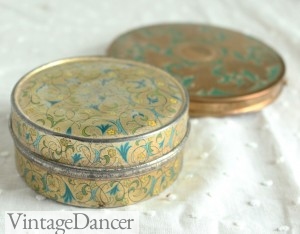
My Grandma’s 1920s Marinello Girl Makeup Powder box
Poor women used home remedies such as ivory face powder, although the tanned look was in and many women shunned the pale skin of the past.
1920s Lipstick
The invention of the metal lipstick tube in 1915 was a welcome addition to a woman’s beauty routine. Now a woman could simply carry her lipstick with her and touch it up as needed. Stencils and metal lip tracers helped ensure perfect application along the lip line.
Matte red was the overwhelming color of choice (sometimes it was cherry-flavored) and by far the most popular application of it was creating the “Cupid’s bow.” This look was also called bee stung lips or rosebud pout because of the full bottom lip and pointed smaller upper lip. A few movie stars applied a beauty mark below the corner of the lip, which some flappers copied.
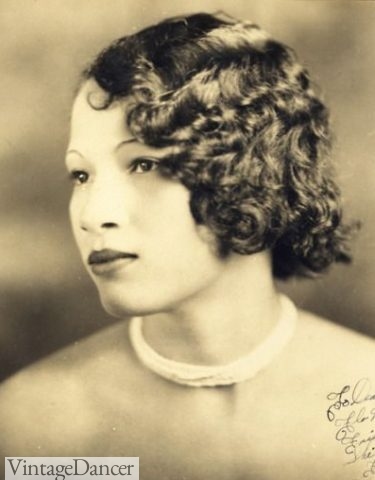
A deep red lipstick
Lip color was coordinated with skin tone. Deep skinned ladies were advised to wear a dark cherry or deep ruby red lipcolor. Fair-skinned ladies would opt for a bright red lipstick instead. Personally, I alternate between bright red and dark “Noir” red lipstick for my fair skin.
- Bright red, almost pink
- Dark red, almost brown
1920s Eye Shadow
For the eyes, the look many aspired to was the dramatic appearance of Clara Bow’s dark, smudged kohl rims. Kohl was also used for eye-shadow, although cream eye-shadow called lining was available later in the decade. Dark grays were the favorite colors, but many women chose shades that matched their eye color:
- Blue eyes: Green or blue eye shadow, brown mascara and eyeliner.
- Green eyes: Grey or green eye shadow, brown mascara and eyeliner.
- Brown eyes: Brown or plum eye shadow, black mascara and eyeliner.
- Black eyes: A very faint red could be applied.
Eye shadow was applied with the fingers, lightly against the lash-line, and then smudged upwards for a smokey effect.
Mascara was still in the development stages. It could be purchased in liquid, wax, or cake form. If you wanted to try Maybelline’s mascara, the company was kind enough to include a brush, which had to be moistened with water before dipping in cake powder, along with a close-up photo of silent film star Mildred Davis for use as a reference. Keep in mind that the brush was not the circular type that is used now, so eyelash curlers, invented in 1923, were quite popular.
1920s Eye Brows
Eyebrows were shaped thin and curved with a slight downward point at the inner end. The thickness of the eye was even all around. Eyeliner, in pencil form, was used on the eyebrow but mostly just as a liner on the top eyelid. It was just brown or black for most of the twenties. Blue or violet came out in the later years, which was drawn on and then smudged for a lighter misty effect.
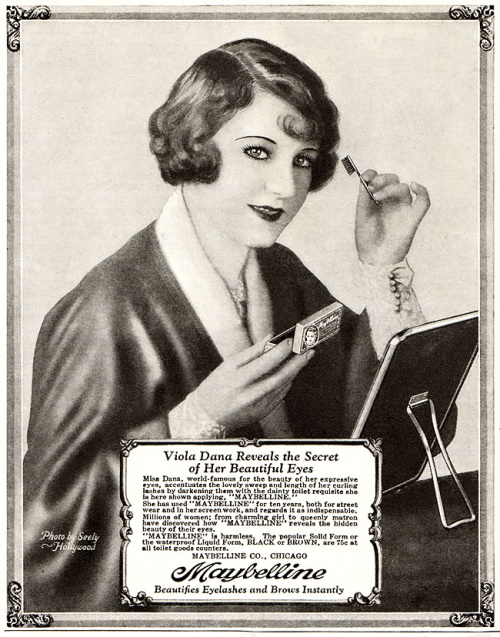
1926 Maybelline Eye Brow set
1920s Nail Polish
When the decade began, nail polish was not common. Thanks to the automobile industry, which perfected new durable paints, the cosmetics industry had something to copy.
- Cutex nail polish ad
- 1920s nail polish
By 1917 Cutex had developed liquid, paste and powder polish. The Cutex line promoted only one color, shell pink, until the very end of the decade when several shades of bright rose, pink, and red expanded the line. Polishes were semi sheer, adding just a hint of color. Clear polish was sold as well.
- Powder polish was placed in the palm of the hand and the finger, nail side down, swiped against the powder a few times. Cake polish was a compressed powder applied the same way.
- Paste Polish was a cream paste that was rubbed onto the nail. A stick version was portable to carry in the purse for on the go application.
- Liquid polish was painted on the nail. This was the favorite application with the least amount of mess.
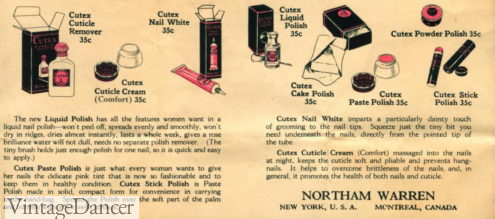
1924 Cutex nail polish guide
In 1928 Cutex introduced an acetone based nail polish remover, safe for home use. Together with cuticle remover, trimmers, creams and polish, women had a complete home manicure set.
The favorite style of manicure was known as the “moon manicure,” polishing only the middle of each nail and leaving the tips white. Nails were oval shaped and slightly pointed.
By the end of the decade, the women’s cosmetic industry had completely transformed. The use of makeup was now not only accepted but also welcomed as a form of self-expression and femininity.
How to Wear 1920s Makeup
I put together a how-to guide for authentic 1920s makeup here. My general feeling about existing tutorials is that they use too many modern techniques and products to achieve a genuine 1920s look worn by real women, not movie stars.
For my sources, I looked at vintage makeup guides and books written in the 1920s. I also use reproduction makeup for the most accurate colors.
Learn about 1920s Fashion History
What Did Women Wear in the 1920s? 20s Fashion Trends
1920s Flapper | History of Flappers in the 1920s
1920s Hairstyles History- Long Hair to Bobbed Hair
Shop for 1920s Outfits
1920s Style Dresses, 1920s Dress Fashions You Will Love
Debbie Sessions has been teaching fashion history and helping people dress for vintage themed events since 2009. She has turned a hobby into VintageDancer.com with hundreds of well researched articles and hand picked links to vintage inspired clothing online. She aims to make dressing accurately (or not) an affordable option for all. Oh, and she dances too.
